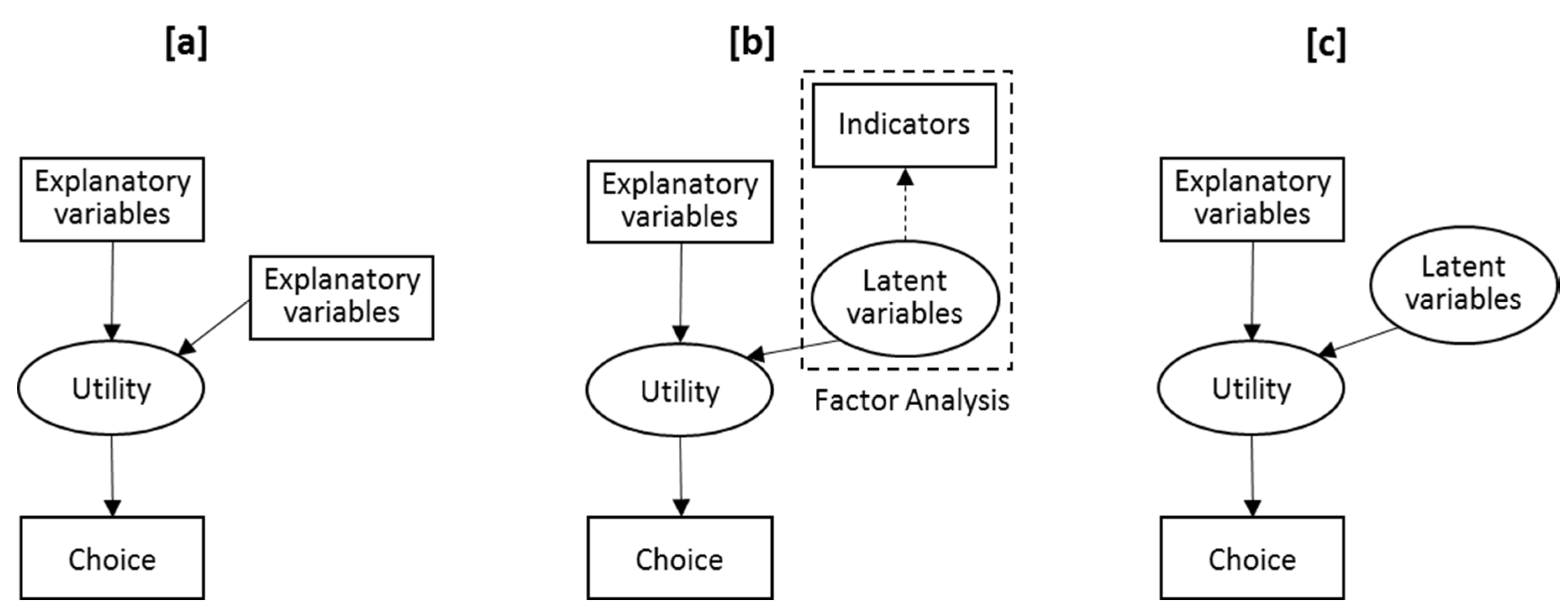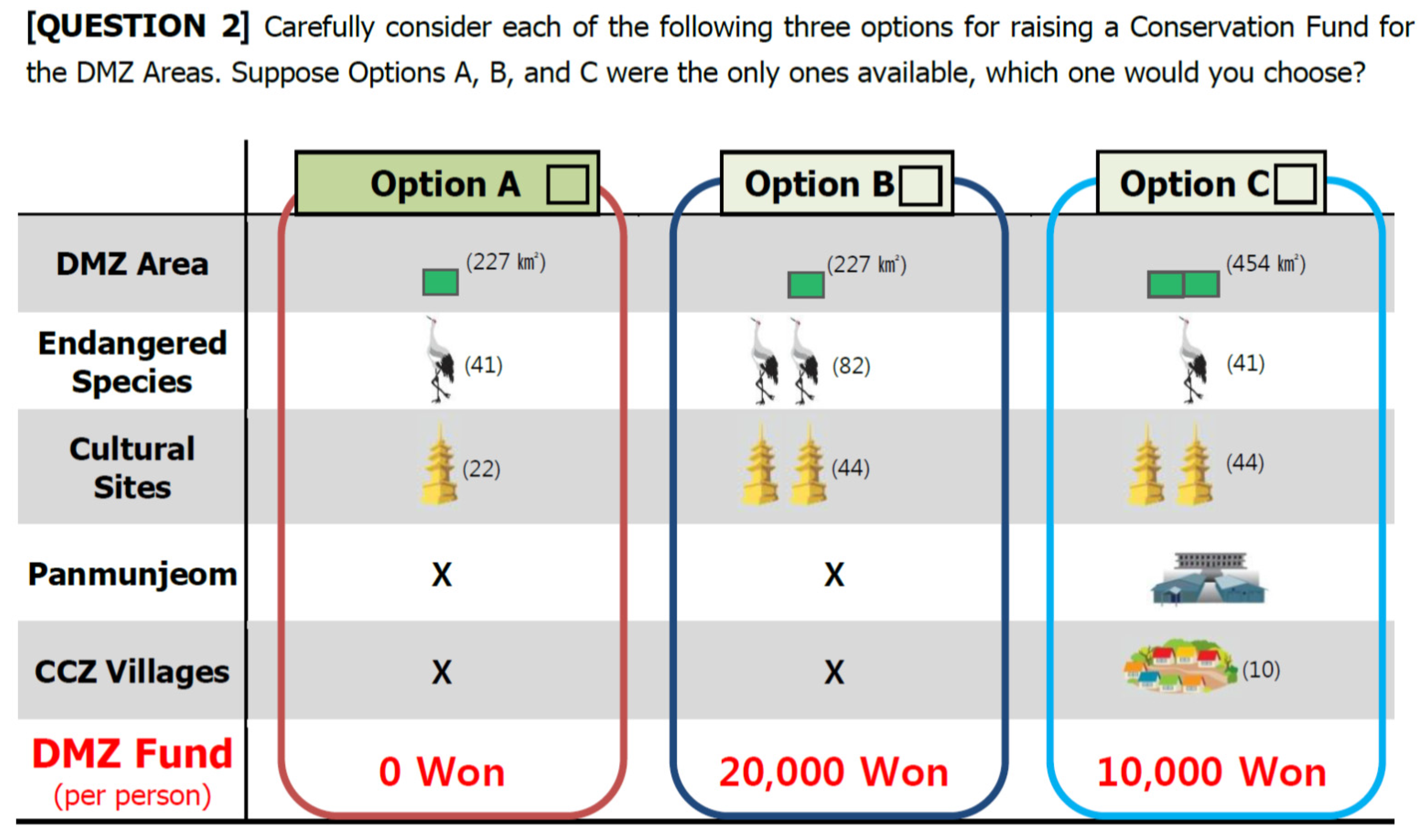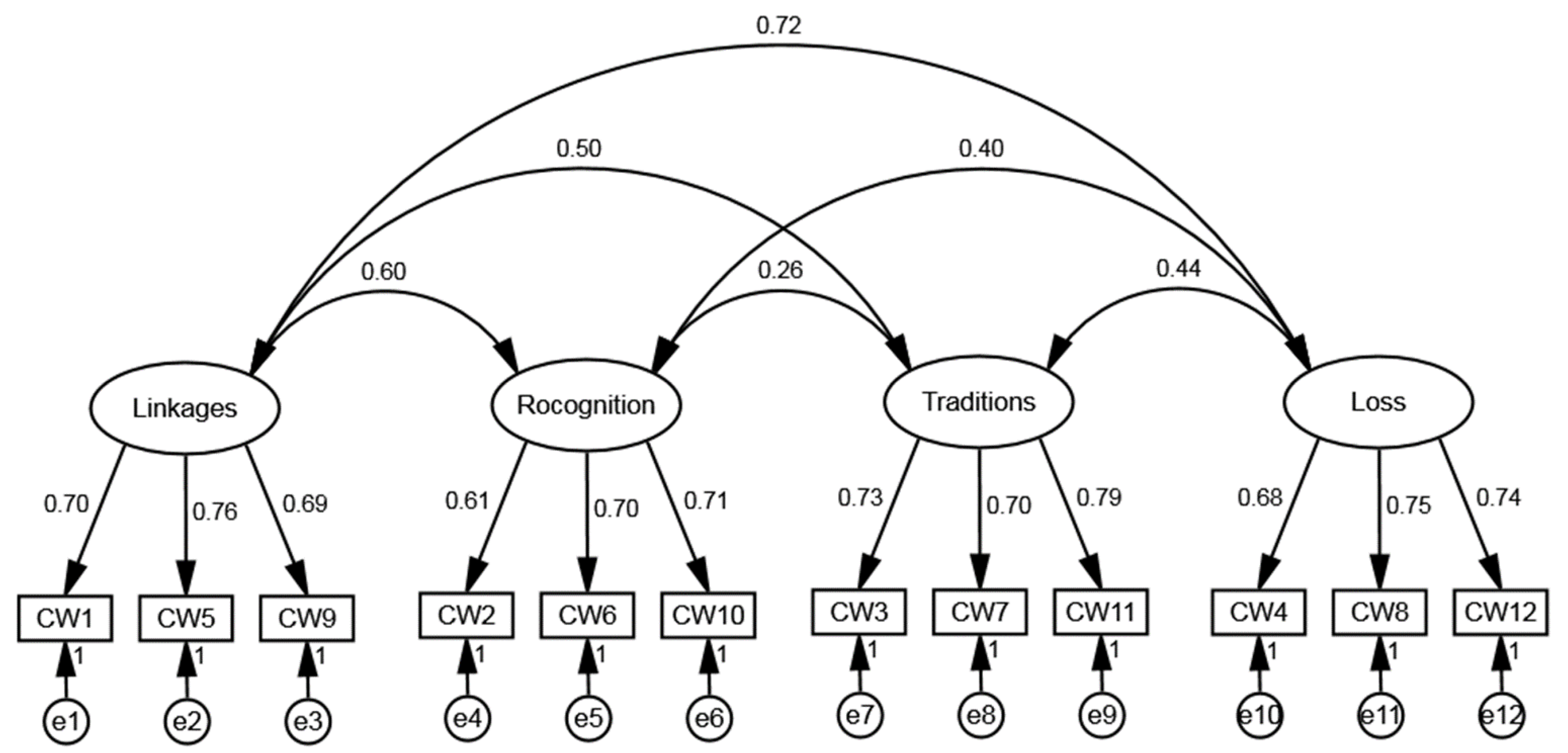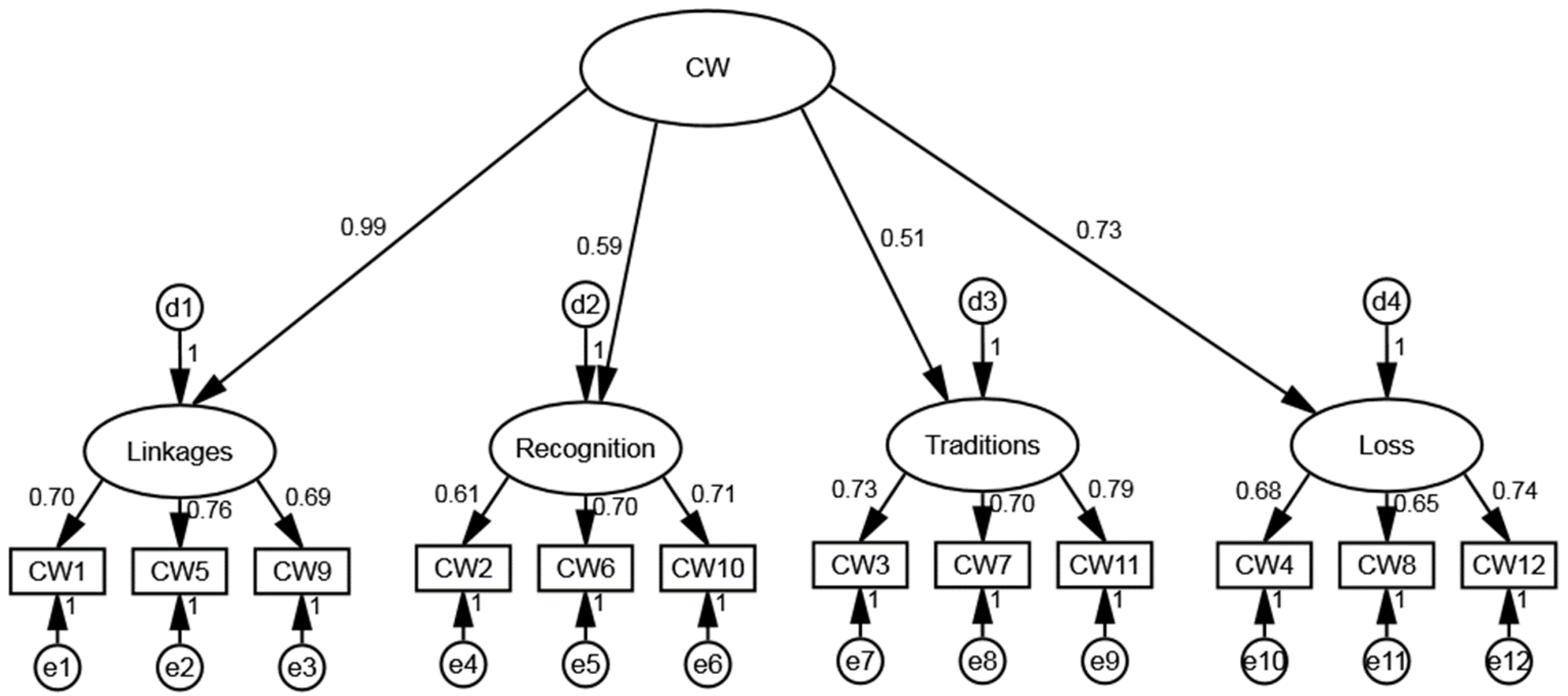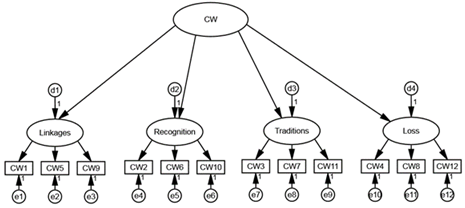1. Introduction
The issue of population heterogeneity plays a critical role in explaining stated preferences in nonmarket valuation studies. Value estimates might not be reliable or valid if this issue is not properly treated [
1,
2]. One way to address population heterogeneity is to incorporate attitudinal characteristics of respondents as a part of standard economic models [
3,
4,
5,
6,
7,
8]. This incorporation is necessary, as researchers are eager to gain more insights into how respondents engage in the choice processes and to improve the explanatory power of choice models [
7,
9,
10,
11]. In environmental studies, the New Ecological Paradigm (NEP) scale of Dunlap
et al. [
12] has been widely applied [
13], linking environmental attitudes to stated preferences or environmentally motivated behavior. However, there has been limited research in the literature of environmental economics and cultural economics dealing with systematic measures of cultural attitudes or general beliefs that assess the cultural concern of respondents. In a wider context, cultural aspects of ecosystem services and how people consider their significance might also be important in understanding human-nature relationships [
14].
Systematic measures of attitudes are different from other
ad hoc indicators such as memberships and institutional trust [
4], by employing scales as measurement instruments. A scale consists of a set of selected statements or manifest items that are expected to assess or reflect theoretical latent variables, constructs, or factors [
15]. Systematic measures of cultural attitudes are useful, and in many cases necessary, to investigate the multidimensional nature of cultural preferences [
16,
17] and to reveal how respondents can vary in their cultural attitudes.
To address this research gap, Choi
et al. [
18] developed a Cultural Worldview (CW) scale that aimed to measure procultural attitudes (
i.e., perceived human-culture relationships) in terms of general beliefs and perceptions (
i.e., general attitudes). Attitudes are broadly defined as a mental state in which a favorable or unfavorable evaluation toward an object is processed [
19]. Building on the multidimensional nature of cultural values [
16,
17], the CW scale addresses the heterogeneity issue of cultural nonmarket valuation by providing additional information about latent constructs of people’s cultural concern and about individual positions in the constructs. Choi
et al. [
18] defined cultural value as the perceived economic significance of cultural goods and services in an effort to explain why some people attach more value (significance or importance) to the same degree of conservation activities involving cultural heritage than others. Alternative definitions are also available in the literature where cultural values can also refer to various social cognitions about culture, which might be of a different entity from economic values of cultural goods and services. Some researchers argue that neoclassical economic models might be unable to reflect cultural values in an appropriate and adequate way [
20]. On the other hand, neoclassical economists might argue that anthropocentric values of cultural goods and services can be transformed into a one-dimensional utility space that can be subsequently delivered as economic values [
21]. It might be possible that “socio-cognitive” cultural values define cultural goods and services, while “economic” cultural values provide their approximate quantity in monetary terms. There is an increasing interest in the literature on measuring cultural attitudes and including them in nonmarket valuation studies [
22,
23].
In effect, both the CW scale and the NEP scale measure attitudinal dispositions that are general and relatively stable in time and context. According to the literature of behavioural psychology, value orientations and beliefs determine specific attitudes and norms that subsequently influence behavioral intentions and actual behaviors [
24,
25,
26]. This suggests that cultural attitudes should be related to outcomes such as cultural heritage protection via intentions to protect cultural heritage sites. As stated preferences in the form of willingness to pay (WTP) are expressions of behavioral intention [
27], we would expect to see a positive relationship between CW scores and WTP estimates [
11]. Systematic and effective measures of general cultural attitudes are important in addressing the heterogeneity issue of nonmarket valuation by revealing unobserved factors of economic models [
28]. Thus, cultural attitudes measured by the CW scale can be considered as motives for stated preferences involving cultural goods and services.
When attitudinal characteristics of respondents are incorporated into economic models as unobserved factors they are normally employed as explanatory variables [
5,
8,
29] or as segmentation criteria for cluster analysis [
30,
31,
32]. Some studies that have applied systematic measurement scales have shown mixed empirical findings for the attitude–WTP association [
3,
4,
6,
33]. The findings of Cooper
et al. [
3] contradicted the significant NEP–WTP relationship that was reported by Kotchen and Reiling [
4], while Choi and Fielding [
6] offered a new insight into a more complex nature of this relationship in the context of discrete choice models. In relation to cultural attitudes specifically, Choi [
33] found that attitudinal traits that were measured using the CW scale might not have significant explanatory power for some cultural WTP estimates. Nonetheless, considering that both stated preferences and attitude–WTP relationships are sensitive to specific contexts [
21], more empirical studies are needed prior to any generalization [
33]. In addition to the need for further research to test the CW–WTP association, the factor structure of the CW scale and its applicability to non-Western contexts also need to be confirmed before its wide use as a measurement scale [
34,
35].
This paper aims to investigate the latent dimensionality underlying the CW scale and to examine attitude–WTP relationships in the context of discrete choice models involving cultural heritage sites. In so doing, it also aims to develop a more parsimonious CW scale that may be more effective and useful for its wide use. Although multiple dimensions are commonly assumed and designed during the development process of measurement scales (e.g., the NEP scale), past research does not always find support for the originally intended structure of scales. For example, the NEP was conceptualized as having five underlying factors, but most research using the scale treats it as one general factor. In addition, the reliability of scales may vary substantially between Western and non-Western populations [
13]. This study offers evidence that the CW scale might provide a reliable multifactor structure across Western and non-Western applications. Confirmatory factor analyses confirm that the scale can be used either as a single second-order factor or four correlated factors. Further, a significant CW–WTP association demonstrates a significant role of the CW scale that reveals unobserved heterogeneity in the economic models, offering future research opportunities for this scale.
In developing and testing a measure of cultural attitudes, this paper makes an important contribution to the literature on cultural sustainability. There is great benefit to researchers, and to the literature more generally, in developing a reliable and parsimonious measure of cultural attitudes that can be used across different cultures. A standard measure allows for comparison of results across studies and for cultural attitudes to be easily measured and incorporated into a range of research settings, including nonmarket valuation studies. This has certainly been the case for the NEP, which is a widely used measure of environmental attitudes that has been used in relation to a range of research topics and, because of its standardization, has allowed for comparisons across those studies [
13].
In terms of paper organization, the following two section introduce major issues of attitudinal scales and theoretical models, and describe the data collection, respectively.
Section 4 reports results from confirmatory factor analyses and the test of attitude–WTP relationships.
Section 5 provides a brief summary of the findings and discussion.
3. Empirical Data
This paper involves a host of cultural heritage sites that are registered at the national and local levels and located along the Demilitarized Zone (DMZ) between North and South Korea, mostly within its southern Civilian Control Zone (for detailed information about this case study, see Choi [
57]). Tourists are allowed to visit only designated sites along the DMZ, in a controlled environment under military supervision. Limited agricultural activities are also possible in the Civilian Control Zone. Since 1953, when the Korean War was put into the Armistice Agreement, these areas have served both as a geopolitical buffer and as a vault of diverse ecological and cultural assets [
64,
65]. Although a few researchers have examined the conservation values of ecological resources in these areas [
57,
66,
67], little has been reported in the literature on the welfare benefits stemming from those cultural heritage sites within the restricted areas of the DMZ. Conservation values of the DMZ resources, including cultural heritage sites, are critically important because the long-awaited unification on the Korean peninsula can lead to a potentially destructive path (
i.e., a careless development rush) for many rare species and heritage sites [
68].
In order to frame choice situations, major resources of the DMZ areas were defined using focus groups, expert consultations, and one pretest (for a detailed description of this qualitative stage, see Choi [
57]). The experimental designs were also improved using a
D-optimal efficient design. As shown in
Table 1, the number of cultural heritage sites (CUL) was one of the six attributes that were employed to describe varying conservation levels. Other attributes included the symbolic areas of the DMZ to be preserved when a peaceful inter-Korean relationship is eventually realized in the future (AREA), the UN guarded negotiation house (“Panmungeom”) as one of many war-related sites (MIL), ten special villages located within the CCZ (VIL), and the number of endangered species (SPE). A voluntary conservation fund (FUND) in Korean Won (KRW) was adopted as a payment vehicle [
67], with varying levels between 2500 KRW (US$2.08) and 20,000 KRW ($16.67).
Questionnaires were developed through focus group reviews and a pre-test involving 100 respondents living in Seoul. Each questionnaire comprised three sections. Respondents were briefly introduced to the purpose of the study and some basic descriptions of the study areas, followed by a valuation section. They were informed that different management options of the DMZ areas can result in a loss of the major resources in the future. After the six attributes were introduced in a simple table, respondents were shown a couple of familiarization questions before they answered six choice questions, as shown in
Figure 2. The first alternative (Option A) served as a reference that represented the hypothetical worst case scenario [
69], which was compared against the other two options that included improved quality in the attributes. The final section was about respondent characteristics, including the original nineteen items of the CW scale.
5. Discussion and Conclusions
The development of the Cultural Worldview (CW) scale has been a response to the paucity of systematic measures of cultural attitudes in the literature of cultural economics and nonmarket valuation. The current research extended previous research on the CW scale by examining key issues associated with the development of an attitudinal scale and identified a more parsimonious version with twelve items. In doing this, it has demonstrated how the scale benefits our understanding of preference heterogeneity involving cultural heritage sites. The scale might be useful for studies that aim to delve into attitudinal profiles of respondents or to segment populations according to perceived cultural importance. In particular, the CW scale can easily be incorporated into economic valuation models that try to address the population heterogeneity issue.
This paper addressed three major issues. As the first of these, a four-factor structure was confirmed as proposed by the scale developers [
18]. This finding thus supports the conceptual belief that cultural value is multidimensional [
16,
17]. Among the four factors, “LINKAGES” and “LOSS” variables might be substantially correlated. Further, confirmatory factor analyses verified the latent structure of the CW scale to be four correlated factors, or one second-order factor with four underlying factors. As to the second issue of developing a more parsimonious version of the scale, this paper presented a shorter list of the twelve items that loaded highest on the factors and demonstrated applicability of this version of the scale in the economic valuation context. Finally, in relation to the third issue, the current study suggests a potential applicability of the CW scale to non-Western nations as well as Western nations. A high level of procultural support in this case study involving Korean respondents was consistent with the findings of the previous Australian cases [
18].
This paper also confirmed that cultural attitudes work as significant motivations for the WTP for the conservation of cultural heritage sites, and as unobserved factors of economic models. General cultural attitudes were measured systematically using the CW scale. Systematic measurement of attitudinal characteristics is crucial for comparative studies, as shown in the literature of environmental studies [
3,
4,
6,
13]. By including CW factors individually, or as the total score as parts of economic models, not only were the model fits improved, but underlying factors for the heterogeneous cultural values were also identified.
The CW scale can be used either as four correlated factors or a single index, depending on the research purposes. As a single index, respondents can be differentiated according to their overall procultural positions. For instance, three equal-size groups can be arbitrarily created and various consumer profiles or relationships among the subgroups can be examined [
6]. Alternatively, researchers can employ four factors as explanatory variables and verify which latent variables carry meaningful relationships with choice attributes. As evidenced in this paper, stated preferences for the conservation of cultural heritage sites in the restricted areas are largely influenced by the perceived importance of traditions and customs, whereas cultural linkages, perceived cultural loss, and recognized cultural significance do not play a significant role. The stable multidimensional structure of this scale provides one avenue for helping researchers to delve into the root causes of culturally meaningful phenomena, which have been previously unavailable to them.
Although the latent dimensionality underlying the CW scale was confirmed and cultural attitudes were found to be significant motivations for WTP, there are several limitations of the research that need to be considered in future studies that investigate the measurement and contribution of cultural worldview. Firstly, the shorter version of the CW scale may be subject to some framing effects. As the new version only includes twelve items out of the original nineteen items, it is not clear whether different sequences and positions of these items cause any impacts on factor scores. Our expectation is to see the same reliable constructs as demonstrated in this study. Follow-up studies can verify this expectation. Secondly, this paper applied only one of the two commonly used methods involving attitudinal variables. As introduced in the beginning, Cultural Worldview measures can also be applied as segmentation criteria, and segment-specific mean WTP estimates can be examined for the statistical relationships. Future research adopting this approach is needed to confirm the findings of the current study. Finally, to date, CW scales have only been used in the context of economic valuation cases. Diverse study contexts need to be investigated in the future, using the same measurement items, such as destination choices involving cultural sites, the demand for intangible cultural goods, and different interpretations of cultural landscapes.
